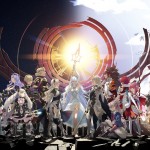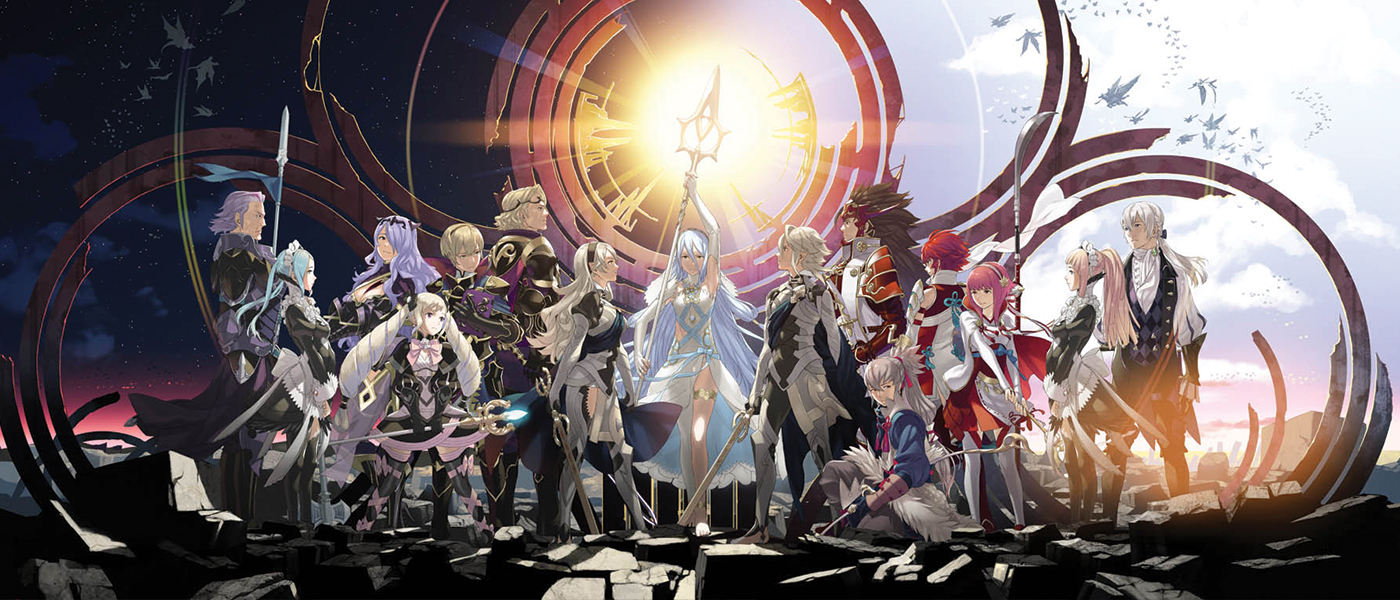AUTHOR’S NOTE: Fire Emblem Fates wasn’t reviewed as separate entries due to the fact that the base gameplay remains the same, only the narrative changes depending on the path chosen.
Released to massive acclaim from both Nintendo fans and critics alike, 2013’s Fire Emblem: Awakening was a great success for both the 3DS and the franchise itself, providing a rebirth for a series on the decline in Japan and cementing the IP amongst Nintendo’s greatest. It also allowed the Western world to truly get a feel for the series, marketed more heavily than previous translations. And now, Intelligent Systems is back at it again with Fire Emblem Fates, promising to be bigger and better than before. With three separate paths to follow that change the story and characters within, Fates takes everything that made Awakening fantastic, and builds on it in so many ways.
 The kingdoms of Hoshido and Nohr have been at war for countless years; forged from bloodlines of ancient dragons existing in that world. You are the avatar, a Hoshidan royal stolen away by the Nohrians as a child and raised with them – only discovering this at a point where tensions between the two sides have reached boiling point. Caught in the midst of the conflict, do you choose to return to your true family (Birthright), side with those who have cared for you throughout the years (Conquest), or ignore the two and forge your own path? The choice is yours to take up arms; to protect the peaceful nature of Hoshido, or to cast away the darkness from within Nohr, and ultimately decide the fate of the two nations.
The kingdoms of Hoshido and Nohr have been at war for countless years; forged from bloodlines of ancient dragons existing in that world. You are the avatar, a Hoshidan royal stolen away by the Nohrians as a child and raised with them – only discovering this at a point where tensions between the two sides have reached boiling point. Caught in the midst of the conflict, do you choose to return to your true family (Birthright), side with those who have cared for you throughout the years (Conquest), or ignore the two and forge your own path? The choice is yours to take up arms; to protect the peaceful nature of Hoshido, or to cast away the darkness from within Nohr, and ultimately decide the fate of the two nations.
 Taking the concepts of light and dark between the two iterations, Fire Emblem Fates retains much of the same looks as its predecessor and builds on them with great detail. For Birthright, Hoshido and its characters have a ‘light’ look to them, embodying the peaceful nature that they seek, whereas Conquest utilizes a darker colour scheme to contrast this and show them as a warring and powerful nation.
Taking the concepts of light and dark between the two iterations, Fire Emblem Fates retains much of the same looks as its predecessor and builds on them with great detail. For Birthright, Hoshido and its characters have a ‘light’ look to them, embodying the peaceful nature that they seek, whereas Conquest utilizes a darker colour scheme to contrast this and show them as a warring and powerful nation.
As with Awakening, Fates utilizes three methods of in-game narrative progression – dialogue text scenes, in-game renders, and pre-rendered cut scenes. As the avatar is customisable, the player’s character is usually only seen in the former two. Each character also gets their own little set of voice clips to accompany actions and dialogue options, giving them a bit more personality than just a drawn avatar on-screen. To add that little bit more personality to the game, there is now a Castle Builder mode, where you can customize your castle and lay it out to your liking (but we’ll get to that later).
Battle scenes in-game remain relatively unchanged from before (character models now have feet!) and battles tend to flow faster than previously. Statistical menus and such are explained in better detail, which helps newcomers to the series understand better just exactly what is taking place on-screen.
Lastly, but definitely not least, the score is again quite addictive and magnificent. The game’s soundtrack employs themes on which each nation is based – for Hoshido, a very Japanese melody, and a more European style for Nohr. This is evident in battle maps and castle scenes. The main theme for the game, a song performed by the character Azura, is also a tune you’re likely to get stuck in your head after enough times hearing it.
 Fire Emblem’s combat is relatively simple, yet can be quite punishing if you aren’t paying attention. The game gives you the option of setting a difficulty level at the start, and also whether you want to play Casual (respawning characters) or Classic (perma-death!). If you play Classic and have a guilt complex like me, prepare to reset your game a hell of a lot to save characters. Permanent death usually results in characters being unplayable for the remainder of the game, though they may still appear in cut scenes throughout.
Fire Emblem’s combat is relatively simple, yet can be quite punishing if you aren’t paying attention. The game gives you the option of setting a difficulty level at the start, and also whether you want to play Casual (respawning characters) or Classic (perma-death!). If you play Classic and have a guilt complex like me, prepare to reset your game a hell of a lot to save characters. Permanent death usually results in characters being unplayable for the remainder of the game, though they may still appear in cut scenes throughout.
As with every other game in the series Fire Emblem is a turn based tactical RPG – characters move around spaces on a map and can attack or heal other units and complete objectives. Different units, such as Archers and Ninja can attack from a distance, while Pegasus Knights and Wyvern Lords can cover a massive distance in single motions. Fates plays extremely similar to its predecessor in Awakening, with most objectives needing players to defeat the enemy to progress.
Units can be paired up to provide support bonuses and harbour relationships between the two, which leads to more story options (including children) opening up later in the game. Paired units don’t usually attack as well together as they do when placed side-by-side, so the more tactical you think, the more you can get out of a turn before the enemy has the chance. A new introduction is the defence mechanic, which allows characters to accumulate defence points which are then used when an enemy attacks, often blocking what is usually an unblockable move. This saved my butt on multiple occasions and allowed me to strategically place characters on the map to progress faster.
Dragon Veins are a new tactical implementation allowing players to change the playing field by tapping into special powers within the earth. These can manifest in the forms of rivers, lightning strikes, avalanches or even whirlwinds which can aid or hinder units on the map, making the terrain tactically difficult for some players. These can only be harnessed by Royal Family members on either side, and not supporting units.
Another new feature allows players to capture enemy units and have them fight for you by convincing them in the prison within your castle. They can choose not to, or you can sacrifice them at your own will. Some units cannot be recruited or captured, so the option to do so usually does not appear. Units that can be recruited without having to be captured end up with a “TALK” option above their head, only seen when moving an appropriate character such as the Avatar nearby.
The main menu screen in Fates has been replaced with the Castle as previously mentioned, where players can upgrade their weapons stores and defences. Other players’ castles can be visited and battled in, allowing resources to be acquired and used in your own castle. This does not affect gameplay in any major way (aside from possibly gaining stronger weapons) and any units that die in a castle invasion will not permanently die within the story itself.
Fates provides the most interesting choice of all, depending on which version you pick; you follow a specific path throughout the game. At its conclusion, you are then able to purchase the opposing game for cheaper as a download, and also the third expansion which completely changes the story. As particular unit classes are only available in one or the other, this makes gameplay a little more interesting between the two games as units all fight differently to one another. The Birthright campaign is the easier of the two – resources are easier to come by, and battles are not as difficult. The Conquest campaign makes things tactically more difficult and resources are a lot harder to obtain, and the Revelation path is suggested only for those who have completed the first two, being the hardest to complete.
 Fire Emblem Fates, regardless of which game you begin with, is a wonderful experience that builds on everything Awakening did right, and makes it even better. Newcomers are welcomed with open arms into the game, and experienced players will enjoy the story and the minor changes that the game brings. Fates is a worthy addition to your collection and a definite threat to your free time; you’ll find yourself wanting to go back for more, even when finished.
Fire Emblem Fates, regardless of which game you begin with, is a wonderful experience that builds on everything Awakening did right, and makes it even better. Newcomers are welcomed with open arms into the game, and experienced players will enjoy the story and the minor changes that the game brings. Fates is a worthy addition to your collection and a definite threat to your free time; you’ll find yourself wanting to go back for more, even when finished.
The 3DS version of Fire Emblem Fates was primarily tested for the purpose of this review


